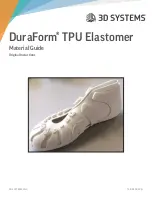
3D SYSTEMS, INC.
75-D059 REV_A
6
Avoid
Preferred
Avoid
Preferred
Cylinders
Cylinders print better if placed vertically in the print area .
This eliminates Z stepping on the sides of the cylinder . If the
cylinder is long and has a small diameter, it can be placed on
its side .
Building a cylinder horizontally may be faster, but building it
vertically will produce a better surface finish. If the cylinder
has another smaller cylinder attached to it and is lying down,
the smaller cylinder should face upward . If the cylinder is
standing up, the smaller cylinder should be oriented in the
direction of the roller .
Ideally and if space is not an issue, cylinders should be built
on their side and at an angle of 30-45 degrees in Z .
Triangles
Place the triangular shapes in the print so that none of the
three sides are perpendicular to the direction of the roller
motion and that the base of the triangle is not facing the top .
This offers less resistance to the material as it flows across
the print bed, thus reducing the possibility of shifting, and
will result in a flatter base.
Cross-sections
Larger cross-sections should be placed in the upper part of
the print to reduce the occurrence of post-print curl .
If the cross-section covers more than half the print area, it
should be rotated around the Y-axis enough so that the total
area that is being scanned on any given slice is minimal . This
will reduce the chance that you will short feed a large section .
Rotating around the Y-axis will yield better part strength than
rotating around the X-axis, but may still cause a short feed if
the section is too long in X .
Orientation for Cylinders
Orientation for Triangles
Orientation for Cross-Section
PART PLACEMENT AND ORIENTATION GUIDELINES
Whenever possible, there are several guidelines that need to be followed to ensure that parts print properly and to get the most
life out of the material .










































